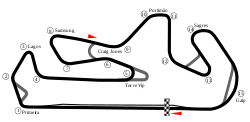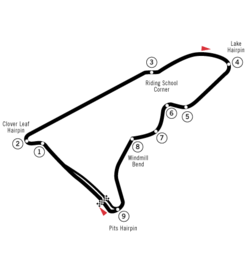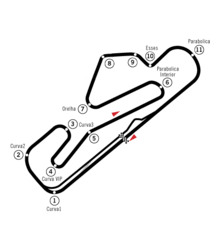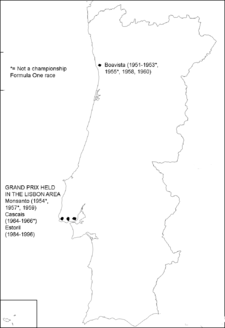Portuguese Grand Prix
The Portuguese Grand Prix (Grande Prémio de Portugal) is a motorsports event held for several years, mostly in the 1950s and then in the 1980s and 90s, which is due to be revived for 2020 for a one-off,[1] changing the location from Lisbon to Algarve. Its first Formula One races were disputed in Circuito da Boavista between 1958 and 1960 and in Autódromo do Estoril between 1984 and 1996.
| Algarve International Circuit (2020) | |
 | |
| Race information | |
|---|---|
| Number of times held | 25 |
| First held | 1951 |
| Most wins (drivers) | |
| Most wins (constructors) | |
| Circuit length | 4.684 km (2.910 mi) |
| Race length | 308.877 km (191.927 mi) |
| Laps | 66 |
| Last race (1996) | |
| Pole position | |
| |
| Podium | |
| |
| Fastest lap | |
| |
History
Boavista and Monsanto (1951–1960)
.svg.png)

The first event was held on the Boavista street course in Porto on 17 June 1951 as a sports car race. The Grand Prix was moved to Monsanto Park, Lisbon, in 1954 as a one-off. Monsanto, like the Boavista circuit was a hazardous street circuit lined with trees and had lots of elevation change and fast sweepers; but Monsanto was quite wide as opposed to Boavista, which was narrow. Sportscar events continued until 1957 when the following year it became part of the Formula One world championship. The first Formula One race was held on 14 August 1958 in Boavista. This circuit was situated in a hazardous area; it was laid out through the town and included sections of cobbled street and even tramlines. British drivers Stirling Moss in a Vanwall and Mike Hawthorn in a Ferrari were at the top of the championship table, battling it out for the first eight rain-interrupted laps. Moss then pulled away as Hawthorn slipped behind Frenchman Jean Behra in a BRM until the British car hit spark plug problems. But the drama was only just beginning as a protest was made against Hawthorn who, it was claimed, when he had restarted his car had driven a few yards in the wrong direction, which was against the rules and meant that Hawthorn was to be disqualified. As soon as he heard it, Moss headed to the stewards and told them Hawthorn had been off the course when he was spotted and that was not against the rules. Moss's evidence swung the decision, and no action was taken. Had the protest been upheld, Hawthorn would have lost seven points – six for finishing second and an extra one for recording the fastest lap. In the event, Moss's intervention allowed Hawthorn to win the Drivers' Championship title by one point – from Moss. This race was followed in 1959 by a Grand Prix at Monsanto, which was won again by Moss, this time in a mid-engined Cooper. Australian Jack Brabham hit a telegraph pole after swerving to hit the twice lapped local driver Mario Cabral; Brabham was thrown out of the car and landed on the track; he was then narrowly missed by American Masten Gregory. After this race, Monsanto Park was abandoned, and F1 returned to Boavista in 1960; this race was won by Brabham in a Cooper. The Portuguese Grand Prix was then discontinued and did not return until 1984.
The name was resurrected for a sports car sprint event in the Cascais street circuit in 1964. The following two years, it was run for Formula Three cars.
Estoril (1984–1996)

The seeds for the return of the Portuguese Grand Prix were planted with the inauguration of the Autódromo do Estoril near the capital of Lisbon in 1972. The Estoril Grand Prix was held as a European Formula Two Championship event during the 1970s. This circuit was to see some of the most memorable and exciting races in Formula One's history. On 21 October 1984, Portugal returned to the F1 calendar, ending the season, where Frenchman Alain Prost won the race but failed to win the Championship by half a point from his teammate, Austrian Niki Lauda who finished 2nd in the race. In 1985, the Grand Prix was moved to April 21 and held under heavy rain, the ideal conditions for Ayrton Senna to win his first race. From 1986, the race was held in what would become its traditional date, in the penultimate week of September; this race was won by Briton Nigel Mansell. 1987 saw Prost win his 28th Grand Prix, breaking Jackie Stewart's 14-year-old record; and 1988 was to see controversy between Prost and his McLaren teammate Senna. Coming out of the long Parabolica corner, Prost lined up to pass Senna but in an attempt to stop him, the Brazilian squeezed the Frenchman and he nearly hit the wall separating the pit lane from the track; but Prost kept his foot flat and passed Senna going into the first corner. Prost, a mild-mannered driver, was angry with Senna. This one incident between the world's 2 best Formula One drivers at the time led to one of the most famous sporting rivalries in history. 1989 saw yet more controversy; Mansell, now driving a Ferrari, overshot his pit lane entrance; and, against his team's gesticulations, went into reverse gear and backed into his pit stop position, which was against the rules. Sometime after Mansell went out, he was given the black disqualification flag. He did not go in, however, and as he came up to pass Senna who was leading while passing the pits and being shown the black flag again, Mansell ducked out, Senna turned into the Ferrari and both drivers went off the track and into the run-off area. This incident just about destroyed Senna's 1989 championship chances. Because he had failed to score any points at this event, he now had to win all 3 races to stand any chance of beating his teammate and rival Prost, who finished 2nd to Mansell's teammate, Austrian Gerhard Berger. Mansell and Ferrari were both fined $50,000 and the Englishman was banned for the next race, the Spanish Grand Prix.
1990 saw an incredibly exciting race, as Senna, Prost, Mansell and Berger all battled hard to gain top honors; Mansell made a very poor start and nearly took out his Ferrari teammate Prost, which allowed Senna and Berger to slip by and take 1st and 2nd. Mansell and Prost fought back; it also saw backmarker Philippe Alliot nearly take out the leader Mansell and crash heavily at the second corner; Alex Caffi and Aguri Suzuki crashed their cars on lap 59; the marshals could not get the cars off the track and the race was called short. Mansell won from Senna and Prost; Berger finished 4th. 1991 saw yet more drama: Mansell (now driving for Williams) then saw his own championship chances start to fade when he came into the pits to change his tires; however the rear right wheel was not fastened down properly and when Mansell went out, he only went about 50 feet before the right rear wheel came off. He was stuck in the middle of the pit road, unable to move. Mansell then reversed the Williams, and the Williams mechanics ran to the stricken car and lifted it bodily while in the pit road and fitted the rear tire properly; which took about a minute. These actions broke all sorts of rules, and Mansell, after coming out in 17th place, was shown the black flag. He had come up to 6th by the time he was disqualified; the race was won by the Englishman's Italian teammate Riccardo Patrese. 1992 saw Mansell win and Patrese have a horrific crash after he hit the back of Gerhard Berger's McLaren and was launched into the air while next to the pit lane. The car came down and scraped alongside the pit wall; no one was injured. 1993 saw Alain Prost win his fourth and final Drivers' Championship driving for Williams; he finished 2nd in the race to German Michael Schumacher in a Benetton.

1994 saw a change to circuit in response to the deaths of Senna and Roland Ratzenberger at Imola. The Esses corner before the Parabolica was made into a 3 corner sequence; the race was won by Williams driver Damon Hill, and 1995 saw a huge accident at the start involving Ukyo Katayama in a Tyrrell; the race was won by David Coulthard. 1996 saw Canadian rookie Jacques Villeneuve in a Williams pass Schumacher on the outside of the Parabolica, and the Canadian won the race. However, the 1996 running was to be the last Portuguese Grand Prix to date. The track tended to promote close racing and the weather was usually good although as Estoril is only a few miles from the westernmost point of Europe, it tended to be affected by stiff breezes and rain storms coming off the Atlantic Ocean. A bigger problem, however, was the local attitude towards the circuit. The FIA asked time and again for the track's facilities to be improved, but nothing was done. In 1997 the governing body called Portugal's bluff; promised renovation work was not done and so the race was canceled. Estoril was planned to be the final of race of 1997 season, but it was replaced with the European Grand Prix, which was held at Jerez in Spain. Portugal's Economy Minister Augusto Mateus immediately announced that the government was going to provide the $6m necessary for the work and that the race was not going to be canceled but he was wrong. In an effort to speed up the work the Portuguese government bought a controlling interest in the company that owned the track. The Portuguese GP was listed on the 1998 calendar but was canceled when the upgrading work could not be completed in time.[2]
Absence
On April 4, 2009 Max Mosley stated that based on the quality of the Algarve International Circuit, the Portuguese Grand Prix could be integrated into the Formula One championship, as long as a commercial agreement with the Formula One Management is achieved.[3]
Portimão (2020)
The race is due to return for the 2020 season this time at the Algarve International Circuit in Portimão to help the sport fill its calendar in light of other races being cancelled due to the COVID-19 pandemic. The race to be held on 25 October 2020 would be the first Grand Prix for this venue.[4]
Official names
Winners
Repeat winners (drivers)
| Wins | Driver | Years won |
|---|---|---|
| 3 | 1984, 1987, 1988 | |
| 1986, 1990, 1992 | ||
| 2 | 1958, 1959 |
Repeat winners (constructors)
A pink background indicates an event which was not part of the Formula One World Championship.
| Wins | Constructor | Years won |
|---|---|---|
| 7 | 1951, 1952, 1953, 1954, 1964, 1989, 1990 | |
| 6 | 1986, 1991, 1992, 1994, 1995, 1996 | |
| 3 | 1959, 1960, 1965 | |
| 1984, 1987, 1988 | ||
| 2 | 1955, 1957 | |
Repeat winners (engine manufacturers)
A pink background indicates an event which was not part of the Formula One World Championship.
| Wins | Manufacturer | Years won |
|---|---|---|
| 7 | 1951, 1952, 1953, 1954, 1964, 1989, 1990 | |
| 6 | 1985, 1991, 1992, 1994, 1995, 1996 | |
| 3 | 1965, 1966, 1993 | |
| 2 | 1986, 1988 | |
| 1984, 1987 | ||
| 1959, 1960 | ||
| 1955, 1957 | ||
* Built by Cosworth
** Built by Porsche
By year

A pink background indicates an event that was not part of the Formula One World Championship. A sports car sprint event in the Cascais street circuit in 1964. The following two years, it was run for Formula Three cars.
References
- "Portimao – Everything you need to know about the Portuguese circuit ahead of its F1 debut". www.formula1.com. Retrieved 24 July 2020.
- "Circuits: Estoril". www.grandprix.com. Archived from the original on 1 November 2001. Retrieved 23 January 2020.
- "Fórmula 1: Max Mosley diz que Autódromo do Algarve pode integrar calendário". expresso.pt. 4 April 2009. Retrieved 18 February 2010.
- "Nurburgring, Portugal and Imola races added to F1 2020 calendar". Sky Sports. Retrieved 24 July 2020.
- "1958 Formula 1 World Championship Programmes | The Motor Racing Programme Covers Project". www.progcovers.com.
- "1960 Formula 1 World Championship Programmes | The Motor Racing Programme Covers Project". www.progcovers.com.
- "1984 Formula 1 World Championship Programmes | The Motor Racing Programme Covers Project". www.progcovers.com.
- "1985 Formula 1 World Championship Programmes | The Motor Racing Programme Covers Project". www.progcovers.com.
- "1986 Formula 1 World Championship Programmes | The Motor Racing Programme Covers Project". www.progcovers.com.
- "1987 Formula 1 World Championship Programmes | The Motor Racing Programme Covers Project". www.progcovers.com.
- "1988 Formula 1 World Championship Programmes | The Motor Racing Programme Covers Project". www.progcovers.com.
- "1989 Formula 1 World Championship Programmes | The Motor Racing Programme Covers Project". www.progcovers.com.
- "1990 Formula 1 World Championship Programmes | The Motor Racing Programme Covers Project". www.progcovers.com.
- "1991 Formula 1 World Championship Programmes | The Motor Racing Programme Covers Project". www.progcovers.com.
- "1993 Formula 1 World Championship Programmes | The Motor Racing Programme Covers Project". www.progcovers.com.
- "1994 Formula 1 World Championship Programmes | The Motor Racing Programme Covers Project". www.progcovers.com.
- "1995 Formula 1 World Championship Programmes | The Motor Racing Programme Covers Project". www.progcovers.com.
- "1996 Formula 1 World Championship Programmes | The Motor Racing Programme Covers Project". www.progcovers.com.
- "1992 Formula 1 World Championship Programmes | The Motor Racing Programme Covers Project". www.progcovers.com.
- "Portugal". Formula1.com. Formula One World Championship Limited. Retrieved 30 July 2020.